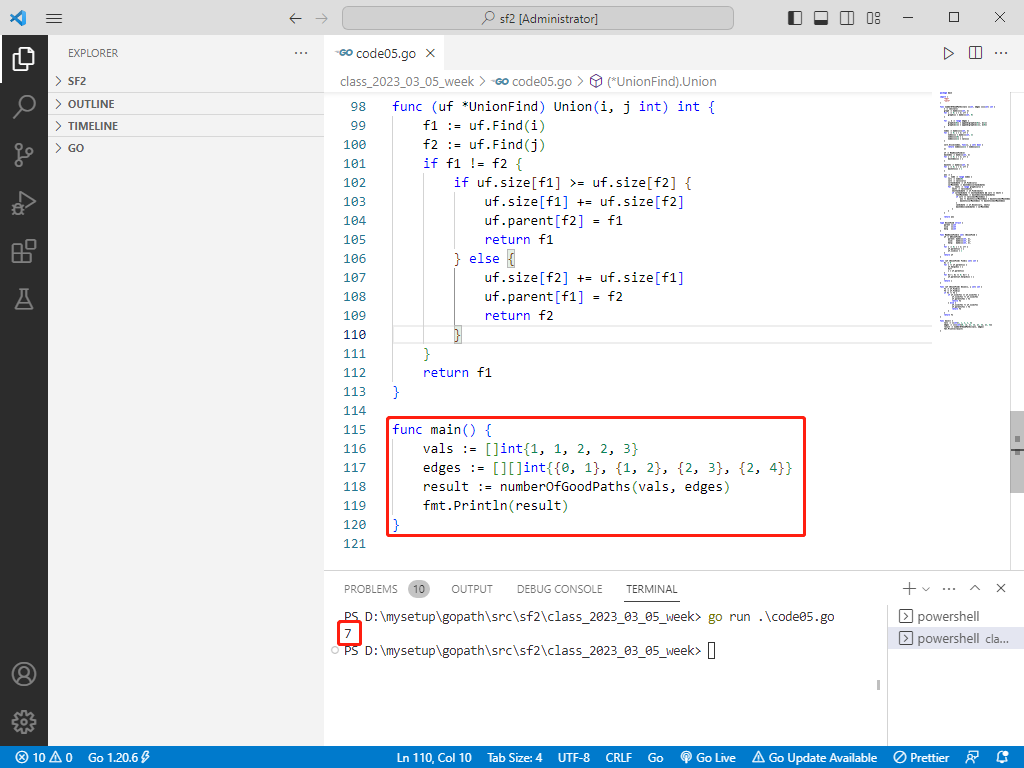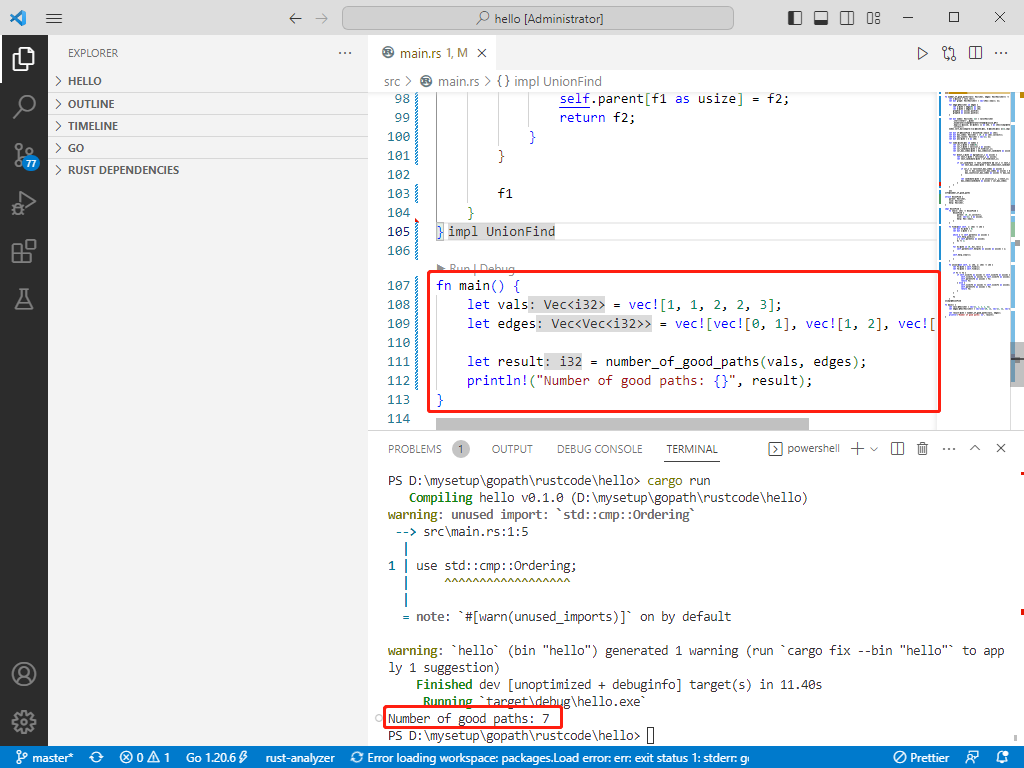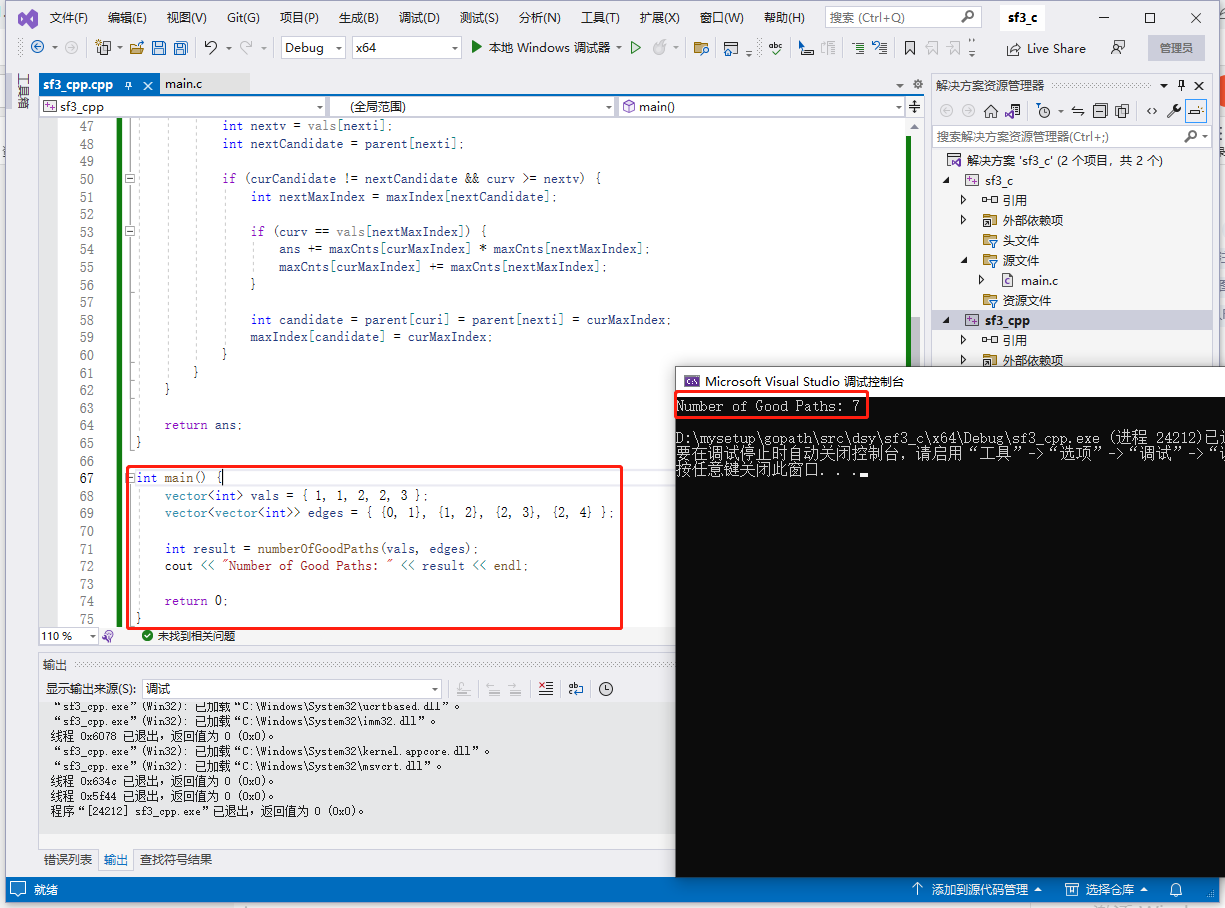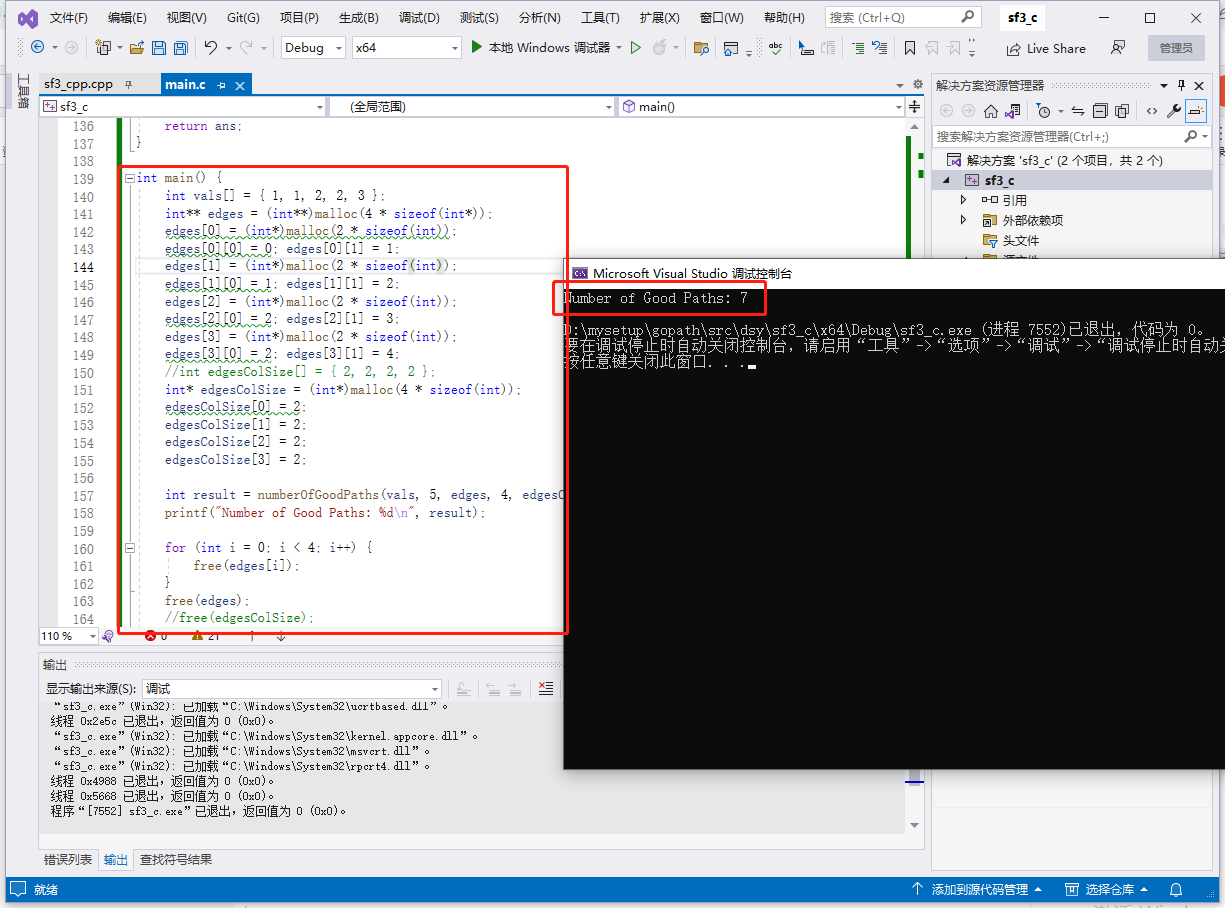2023-08-08: Darle un árbol de n nodos (gráfico conectado no dirigido y acíclico)
Los nodos están numerados de 0 a n - 1 y tienen exactamente n - 1 aristas
Se le proporciona una matriz de valores enteros de longitud n indexada desde 0
Representar el valor de cada nodo por separado.
Al mismo tiempo, le daremos una matriz de enteros bidimensional.
Donde bordes[i] = [ai, bi] significa que hay un borde no dirigido entre los nodos ai y bi
Un buen camino debe cumplir las siguientes condiciones:
El nodo inicial y el nodo final tienen el mismo valor.
Todos los valores de nodo entre el nodo inicial y el nodo final son menores o iguales al valor del nodo inicial.
(Es decir, el valor del nodo de inicio debe ser el valor máximo de todos los nodos de la ruta).
Devuelva el número de buenas rutas diferentes.
Tenga en cuenta que un camino y su camino inverso cuentan como el mismo camino.
Por ejemplo, 0 -> 1 se considera la misma ruta que 1 -> 0. Un solo nodo también se considera una ruta legal.
Entrada: vals = [1,1,2,2,3], bordes = [[0,1],[1,2],[2,3],[2,4]].
Salida: 7.
de Google.
de Zuo Shen
Respuesta 2023-08-08:
Los pasos generales son los siguientes:
1. Cree una estructura de datos de gráfico (árbol) e inicialice los valores y las conexiones de los nodos.
2. Ordene los valores de los nodos y procese los nodos en orden de valor.
3. Inicialice y verifique el conjunto, que se utiliza para administrar la conectividad de los nodos.
4. Cree una matriz para registrar el índice del nodo con el valor más grande en cada componente conectado.
5. Cree una matriz para registrar el número de nodos en el componente conectado donde se encuentra el nodo con el mayor valor en cada componente conectado.
6. Inicialice la respuesta como el número total de nodos.
7. Recorra la lista ordenada de nodos y procese cada nodo por turno:
7.1 Obtenga el índice y el valor del nodo actual.
7.2 Encuentre el nodo representativo del componente conectado del nodo actual.
7.3 Encuentre el índice del nodo máximo que representa el nodo del componente conectado actual.
7.4 Atraviese los nodos vecinos del nodo actual y compare el valor del nodo vecino con el valor del nodo actual.
7.5 Si el valor del nodo vecino es menor o igual que el valor del nodo actual, y el componente conectado donde se encuentra el nodo vecino es diferente del componente conectado actual, realice las siguientes operaciones:
7.5.1 Hallar el índice del nodo de valor máximo del nodo representativo de la componente conexa del nodo vecino.
7.5.2 Si el valor del nodo vecino es igual al valor del nodo de valor máximo, actualice la respuesta y acumule el número de componentes conectados donde se encuentra el nodo de valor máximo.
7.5.3 Combinar los componentes conectados del nodo actual y los nodos vecinos.
7.5.4 Actualice el índice del nodo que representa el componente conectado actual.
8. Devuelva la respuesta.
La complejidad del tiempo es O(nlogn).
La complejidad del espacio es O(n).
El código completo de go es el siguiente:
package main
import (
"fmt"
"sort"
)
func numberOfGoodPaths(vals []int, edges [][]int) int {
n := len(vals)
graph := make([][]int, n)
for i := 0; i < n; i++ {
graph[i] = make([]int, 0)
}
for _, e := range edges {
graph[e[0]] = append(graph[e[0]], e[1])
graph[e[1]] = append(graph[e[1]], e[0])
}
nodes := make([][]int, n)
for i := 0; i < n; i++ {
nodes[i] = make([]int, 2)
nodes[i][0] = i
nodes[i][1] = vals[i]
}
sort.Slice(nodes, func(i, j int) bool {
return nodes[i][1] < nodes[j][1]
})
uf := NewUnionFind(n)
maxIndex := make([]int, n)
for i := 0; i < n; i++ {
maxIndex[i] = i
}
maxCnts := make([]int, n)
for i := 0; i < n; i++ {
maxCnts[i] = 1
}
ans := n
for _, node := range nodes {
curi := node[0]
curv := vals[curi]
curCandidate := uf.Find(curi)
curMaxIndex := maxIndex[curCandidate]
for _, nexti := range graph[curi] {
nextv := vals[nexti]
nextCandidate := uf.Find(nexti)
if curCandidate != nextCandidate && curv >= nextv {
nextMaxIndex := maxIndex[nextCandidate]
if curv == vals[nextMaxIndex] {
ans += maxCnts[curMaxIndex] * maxCnts[nextMaxIndex]
maxCnts[curMaxIndex] += maxCnts[nextMaxIndex]
}
candidate := uf.Union(curi, nexti)
maxIndex[candidate] = curMaxIndex
}
}
}
return ans
}
type UnionFind struct {
parent []int
size []int
help []int
}
func NewUnionFind(n int) *UnionFind {
uf := &UnionFind{
parent: make([]int, n),
size: make([]int, n),
help: make([]int, n),
}
for i := 0; i < n; i++ {
uf.parent[i] = i
uf.size[i] = 1
}
return uf
}
func (uf *UnionFind) Find(i int) int {
hi := 0
for i != uf.parent[i] {
uf.help[hi] = i
hi++
i = uf.parent[i]
}
for hi--; hi >= 0; hi-- {
uf.parent[uf.help[hi]] = i
}
return i
}
func (uf *UnionFind) Union(i, j int) int {
f1 := uf.Find(i)
f2 := uf.Find(j)
if f1 != f2 {
if uf.size[f1] >= uf.size[f2] {
uf.size[f1] += uf.size[f2]
uf.parent[f2] = f1
return f1
} else {
uf.size[f2] += uf.size[f1]
uf.parent[f1] = f2
return f2
}
}
return f1
}
func main() {
vals := []int{
1, 1, 2, 2, 3}
edges := [][]int{
{
0, 1}, {
1, 2}, {
2, 3}, {
2, 4}}
result := numberOfGoodPaths(vals, edges)
fmt.Println(result)
}

El código completo de rust es el siguiente:
use std::cmp::Ordering;
fn number_of_good_paths(vals: Vec<i32>, edges: Vec<Vec<i32>>) -> i32 {
let n = vals.len();
let mut graph: Vec<Vec<i32>> = vec![Vec::new(); n];
for edge in edges {
let a = edge[0] as i32;
let b = edge[1] as i32;
graph[a as usize].push(b);
graph[b as usize].push(a);
}
let mut nodes: Vec<[i32; 2]> = vals
.iter()
.enumerate()
.map(|(i, &v)| [i as i32, v as i32])
.collect();
nodes.sort_by(|a, b| a[1].cmp(&b[1]));
let mut uf = UnionFind::new(n as i32);
let mut max_index: Vec<i32> = (0..n as i32).collect();
let mut max_counts: Vec<i32> = vec![1; n];
let mut ans = n as i32;
for node in nodes {
let cur_i = node[0];
let cur_v = vals[cur_i as usize];
let cur_candidate = uf.find(cur_i);
let cur_max_index = max_index[cur_candidate as usize];
for &next_i in &graph[cur_i as usize] {
let next_v = vals[next_i as usize];
let next_candidate = uf.find(next_i);
if cur_candidate != next_candidate && cur_v >= next_v {
let next_max_index = max_index[next_candidate as usize];
if cur_v == vals[next_max_index as usize] {
ans += max_counts[cur_max_index as usize] * max_counts[next_max_index as usize];
max_counts[cur_max_index as usize] += max_counts[next_max_index as usize];
}
let candidate = uf.union(cur_i, next_i);
max_index[candidate as usize] = cur_max_index;
}
}
}
ans
}
struct UnionFind {
parent: Vec<i32>,
size: Vec<i32>,
help: Vec<i32>,
}
impl UnionFind {
fn new(n: i32) -> UnionFind {
UnionFind {
parent: (0..n).collect(),
size: vec![1; n as usize],
help: Vec::new(),
}
}
fn find(&mut self, i: i32) -> i32 {
let mut hi = 0;
let mut x = i;
while x != self.parent[x as usize] {
self.help.push(x);
x = self.parent[x as usize];
hi += 1;
}
for hi in (0..hi).rev() {
self.parent[self.help[hi as usize] as usize] = x;
}
self.help.clear();
x
}
fn union(&mut self, i: i32, j: i32) -> i32 {
let f1 = self.find(i);
let f2 = self.find(j);
if f1 != f2 {
if self.size[f1 as usize] >= self.size[f2 as usize] {
self.size[f1 as usize] += self.size[f2 as usize];
self.parent[f2 as usize] = f1;
return f1;
} else {
self.size[f2 as usize] += self.size[f1 as usize];
self.parent[f1 as usize] = f2;
return f2;
}
}
f1
}
}
fn main() {
let vals = vec![1, 1, 2, 2, 3];
let edges = vec![vec![0, 1], vec![1, 2], vec![2, 3], vec![2, 4]];
let result = number_of_good_paths(vals, edges);
println!("Number of good paths: {}", result);
}

El código completo de C++ es el siguiente:
#include <iostream>
#include <vector>
#include <algorithm>
using namespace std;
int numberOfGoodPaths(vector<int>& vals, vector<vector<int>>& edges) {
int n = vals.size();
// Build the graph
vector<vector<int>> graph(n);
for (auto& edge : edges) {
int a = edge[0];
int b = edge[1];
graph[a].push_back(b);
graph[b].push_back(a);
}
// Sort the nodes based on values
vector<pair<int, int>> nodes;
for (int i = 0; i < n; i++) {
nodes.push_back({
vals[i], i });
}
sort(nodes.begin(), nodes.end());
vector<int> parent(n);
vector<int> size(n, 1);
vector<int> maxIndex(n);
vector<int> maxCnts(n, 1);
for (int i = 0; i < n; i++) {
parent[i] = i;
maxIndex[i] = i;
}
int ans = n;
// Traverse the nodes in ascending order of values
for (int i = 0; i < n; i++) {
int curi = nodes[i].second;
int curv = vals[curi];
int curCandidate = parent[curi];
int curMaxIndex = maxIndex[curCandidate];
// Iterate over the neighbors
for (int nexti : graph[curi]) {
int nextv = vals[nexti];
int nextCandidate = parent[nexti];
if (curCandidate != nextCandidate && curv >= nextv) {
int nextMaxIndex = maxIndex[nextCandidate];
if (curv == vals[nextMaxIndex]) {
ans += maxCnts[curMaxIndex] * maxCnts[nextMaxIndex];
maxCnts[curMaxIndex] += maxCnts[nextMaxIndex];
}
int candidate = parent[curi] = parent[nexti] = curMaxIndex;
maxIndex[candidate] = curMaxIndex;
}
}
}
return ans;
}
int main() {
vector<int> vals = {
1, 1, 2, 2, 3 };
vector<vector<int>> edges = {
{
0, 1}, {
1, 2}, {
2, 3}, {
2, 4} };
int result = numberOfGoodPaths(vals, edges);
cout << "Number of Good Paths: " << result << endl;
return 0;
}

El código completo de c es el siguiente:
#include <stdio.h>
#include <stdlib.h>
struct UnionFind {
int* parent;
int* size;
int* help;
};
struct UnionFind* createUnionFind(int n) {
struct UnionFind* uf = (struct UnionFind*)malloc(sizeof(struct UnionFind));
uf->parent = (int*)malloc(n * sizeof(int));
uf->size = (int*)malloc(n * sizeof(int));
uf->help = (int*)malloc(n * sizeof(int));
int i;
for (i = 0; i < n; i++) {
uf->parent[i] = i;
uf->size[i] = 1;
}
return uf;
}
int find(struct UnionFind* uf, int i) {
int hi = 0;
while (i != uf->parent[i]) {
uf->help[hi++] = i;
i = uf->parent[i];
}
for (hi--; hi >= 0; hi--) {
uf->parent[uf->help[hi]] = i;
}
return i;
}
int unionSet(struct UnionFind* uf, int i, int j) {
int f1 = find(uf, i);
int f2 = find(uf, j);
if (f1 != f2) {
if (uf->size[f1] >= uf->size[f2]) {
uf->size[f1] += uf->size[f2];
uf->parent[f2] = f1;
return f1;
}
else {
uf->size[f2] += uf->size[f1];
uf->parent[f1] = f2;
return f2;
}
}
return f1;
}
// Comparison function for qsort
int compare(const void* a, const void* b) {
int* na = *(int**)a;
int* nb = *(int**)b;
return na[1] - nb[1];
}
int numberOfGoodPaths(int* vals, int valsSize, int** edges, int edgesSize, int* edgesColSize) {
int n = valsSize;
int i, j;
// 创建图
int** graph = (int**)malloc(n * sizeof(int*));
for (i = 0; i < n; i++) {
graph[i] = (int*)malloc(n * sizeof(int));
edgesColSize[i] = 0;
}
for (i = 0; i < edgesSize; i++) {
int u = edges[i][0];
int v = edges[i][1];
graph[u][edgesColSize[u]++] = v;
graph[v][edgesColSize[v]++] = u;
}
// 创建节点数组
int** nodes = (int**)malloc(n * sizeof(int*));
for (i = 0; i < n; i++) {
nodes[i] = (int*)malloc(2 * sizeof(int));
nodes[i][0] = i;
nodes[i][1] = vals[i];
}
// 根据节点值排序
qsort(nodes, n, sizeof(nodes[0]),compare);
// 创建并初始化并查集
struct UnionFind* uf = createUnionFind(n);
int* maxIndex = (int*)malloc(n * sizeof(int));
int* maxCnts = (int*)malloc(n * sizeof(int));
for (i = 0; i < n; i++) {
maxIndex[i] = i;
maxCnts[i] = 1;
}
int ans = n;
// 遍历节点
for (i = 0; i < n; i++) {
int curi = nodes[i][0];
int curv = vals[curi];
int curCandidate = find(uf, curi);
int curMaxIndex = maxIndex[curCandidate];
// 遍历邻居
for (j = 0; j < edgesColSize[curi]; j++) {
int nexti = graph[curi][j];
int nextv = vals[nexti];
int nextCandidate = find(uf, nexti);
if (curCandidate != nextCandidate && curv >= nextv) {
int nextMaxIndex = maxIndex[nextCandidate];
if (curv == vals[nextMaxIndex]) {
ans += maxCnts[curMaxIndex] * maxCnts[nextMaxIndex];
maxCnts[curMaxIndex] += maxCnts[nextMaxIndex];
}
int candidate = unionSet(uf, curi, nexti);
maxIndex[candidate] = curMaxIndex;
}
}
}
// 释放内存
for (i = 0; i < n; i++) {
free(graph[i]);
free(nodes[i]);
}
free(graph);
free(nodes);
free(maxIndex);
free(maxCnts);
free(uf->parent);
free(uf->size);
free(uf->help);
free(uf);
return ans;
}
int main() {
int vals[] = {
1, 1, 2, 2, 3 };
int** edges = (int**)malloc(4 * sizeof(int*));
edges[0] = (int*)malloc(2 * sizeof(int));
edges[0][0] = 0; edges[0][1] = 1;
edges[1] = (int*)malloc(2 * sizeof(int));
edges[1][0] = 1; edges[1][1] = 2;
edges[2] = (int*)malloc(2 * sizeof(int));
edges[2][0] = 2; edges[2][1] = 3;
edges[3] = (int*)malloc(2 * sizeof(int));
edges[3][0] = 2; edges[3][1] = 4;
//int edgesColSize[] = { 2, 2, 2, 2 };
int* edgesColSize = (int*)malloc(4 * sizeof(int));
edgesColSize[0] = 2;
edgesColSize[1] = 2;
edgesColSize[2] = 2;
edgesColSize[3] = 2;
int result = numberOfGoodPaths(vals, 5, edges, 4, edgesColSize);
printf("Number of Good Paths: %d\n", result);
for (int i = 0; i < 4; i++) {
free(edges[i]);
}
free(edges);
//free(edgesColSize);
return 0;
}
